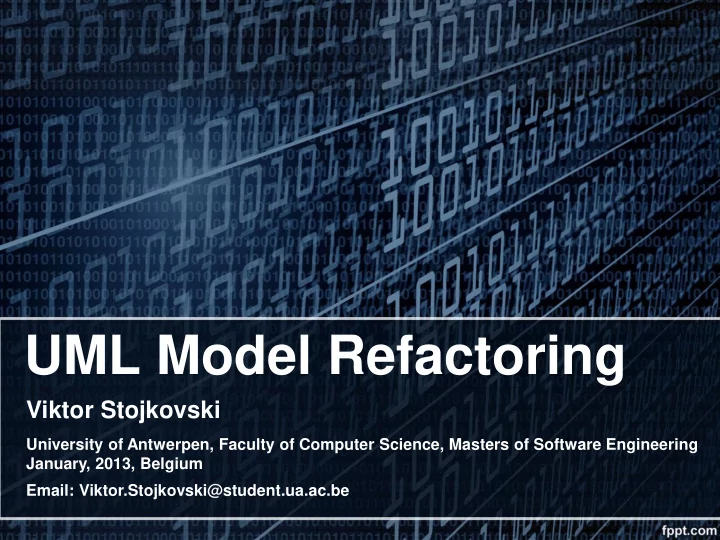

UML Model Refactoring Viktor Stojkovski University of Antwerpen, Faculty of Computer Science, Masters of Software Engineering January, 2013, Belgium Email: Viktor.Stojkovski@student.ua.ac.be
Introduction to UML Model Refactoring • Because of constant evolution, systems must be modified and evolve • There is no precise validation whether the modifications won’t change the system behavior • Necessity of basic set of model transformations (refactorings)
Main goal of the project • Create UML Statechart refactoring rules using the defined transformations in the article Refactoring UML Models • Define GraphGrammar rules using the Meta-Modeling software AToM 3 - Sunye, G., Pollet, D., Traon, Y. L., Jezequel, J.-M., 2001. Refactoring UML Models. Springer. - http://atom3.cs.mcgill.ca/
Working process(1) 1. Reading and understanding the defined rules and the OCL (Object Constraint Language) constraints 2. Create a testing model in AToM 3 using the DCharts as formalism Group States model example Feng, H., 2004. Dcharts, a formalism for modeling and simulation based design of reactive software systems
Working process(2) 3. Specify the grammar by creating the rules – LHS and RHS Group States rule example
Working process(3) 4. Add conditions to the rules as pre- conditions and actions as post-conditions 5. Program the pre and post conditions in Python Acton for the FIA rule Precondition for the Fold Incoming Actions rule
Working process(4) 6. Organizing the rules in the grammar by giving them priorities – The order of the rules is very important (explanation!?) Hierarchy of the rules in the GG
Working process(5) 7. Executing the grammar 8. Analyzing the results: – Does the execution of the grammar over the statechart give the expected results? – Is the model behavior preserved? Example of the Group State rule execution
Presentation of an example from the practical work of the project • Refactoring a Statechart diagram that is modeling a phone call • Explanation of the refactoring process through an examples • Comparing the results of the refactoring to the theoretical results from the article Sunye, G., Pollet, D., Traon, Y. L., Jezequel, J.-M., 2001. Refactoring UML Models
Conclusion • After testing the refactoring grammar on a number of UML Statechart models the results were satisfactory • Room for improvements: – More wide-ranging pre and post conditions covering all of the states in which the model can be – Inventing new and expanding the already specified refactoring rules (example with the extension of the Move State out of Composite rule)
References • Feng, H., 2004. Dcharts, a formalism for modeling and simulation based design of reactive software systems. A Masters Thesis • OMG, 2009. OMG Object Constraint Language (OCL). OMG • Selic, B., 2009. Unified Modeling Language Specification (version 2.1). OMG • Sunye, G., Pollet, D., Traon, Y. L., Jezequel, J.-M., 2001. Refactoring UML Models. Springer • Yang, M., Michaelson, G. J., Pooley, R. J., 2008. Formal action semantics for a UML action language. Journal of Universal Computer Science • http://atom3.cs.mcgill.ca/
Questions & Discussion
Recommend
More recommend